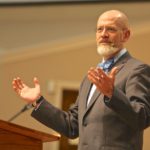 Article by TurretinFan: Three Days and Three Nights – Hebrew Idiom for Three Consecutive Calendar Days (original source here)
Article by TurretinFan: Three Days and Three Nights – Hebrew Idiom for Three Consecutive Calendar Days (original source here)
Jonah’s use of “three days and three nights” repeated by Jesus in prophesying his own death, burial, and resurrection has led to some confusion. As you may recall, in Jonah, it is written:
Jonah 1:15-17
So they took up Jonah, and cast him forth into the sea: and the sea ceased from her raging. Then the men feared the Lord exceedingly, and offered a sacrifice unto the Lord, and made vows. Now the Lord had prepared a great fish to swallow up Jonah. And Jonah was in the belly of the fish three days and three nights.
Similarly, Jesus states:
Matthew 12:38-41
Then certain of the scribes and of the Pharisees answered, saying, Master, we would see a sign from thee. But he answered and said unto them, An evil and adulterous generation seeketh after a sign; and there shall no sign be given to it, but the sign of the prophet Jonas: for as Jonas was three days and three nights in the whale’s belly; so shall the Son of man be three days and three nights in the heart of the earth. The men of Nineveh shall rise in judgment with this generation, and shall condemn it: because they repented at the preaching of Jonas; and, behold, a greater than Jonas is here.
Some people have taken this expression as expressing emphasis on both daylight and and dark periods, instead of understanding the expression as simply meaning three consecutive calendar days.
Interestingly enough, the same expression is found in one other place, where it is fairly clear that three calendar days is meant:
1 Samuel 30:1 & 11-14
And it came to pass, when David and his men were come to Ziklag on the third day, that the Amalekites had invaded the south, and Ziklag, and smitten Ziklag, and burned it with fire; … And they found an Egyptian in the field, and brought him to David, and gave him bread, and he did eat; and they made him drink water; and they gave him a piece of a cake of figs, and two clusters of raisins: and when he had eaten, his spirit came again to him: for he had eaten no bread, nor drunk any water, three days and three nights. And David said unto him, To whom belongest thou? and whence art thou? And he said, I am a young man of Egypt, servant to an Amalekite; and my master left me, because three days agone I fell sick. We made an invasion upon the south of the Cherethites, and upon the coast which belongeth to Judah, and upon the south of Caleb; and we burned Ziklag with fire.
The point of “three days and three nights” is just that the Egyptian had been continuously without food and water for three calendar days. The point is not the day and light portions, but the continuity. We see that from the fact that David returned “on the third day” (vs. 1) and from the fact that the Egyptian had only fallen sick “three days agone.”
The way that “on the third day” worked for the Hebrew way of counting days can be seen from Jesus’ own use:
Luke 13:32 And he said unto them, Go ye, and tell that fox, Behold, I cast out devils, and I do cures to day and to morrow, and the third day I shall be perfected.
Similarly, in Leviticus:
Leviticus 19:6 It shall be eaten the same day ye offer it, and on the morrow: and if ought remain until the third day, it shall be burnt in the fire.
Even in 1 Samuel, we see the same way of counting:
1 Samuel 20:5 And David said unto Jonathan, Behold, to morrow is the new moon, and I should not fail to sit with the king at meat: but let me go, that I may hide myself in the field unto the third day at even. Continue reading

 Dr. James White:
Dr. James White: Article: 10 Historical Facts About Jesus From Non-Christian Sources by Alisa Childers (original source
Article: 10 Historical Facts About Jesus From Non-Christian Sources by Alisa Childers (original source  Dr. Sam Storms: (original source
Dr. Sam Storms: (original source  Article by Paul Rezkalla (original source
Article by Paul Rezkalla (original source